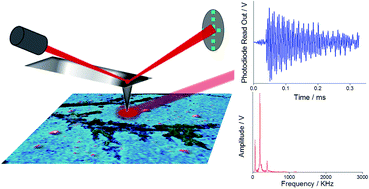当前位置:
X-MOL 学术
›
J. Mater. Chem. A
›
论文详情
Our official English website, www.x-mol.net, welcomes your feedback! (Note: you will need to create a separate account there.)
AFM-IR insights into the chemistry of interfacial tracking
Journal of Materials Chemistry A ( IF 11.9 ) Pub Date : 2017-11-10 00:00:00 , DOI: 10.1039/c7ta06642b Suzanne Morsch 1, 2, 3, 4, 5 , Pablo D. Bastidas 3, 4, 5, 6 , Simon M. Rowland 3, 4, 5, 6
Journal of Materials Chemistry A ( IF 11.9 ) Pub Date : 2017-11-10 00:00:00 , DOI: 10.1039/c7ta06642b Suzanne Morsch 1, 2, 3, 4, 5 , Pablo D. Bastidas 3, 4, 5, 6 , Simon M. Rowland 3, 4, 5, 6
Affiliation

|
Composite materials are increasingly used in high-voltage insulation, where interfacial aging is a major source of failure. Nonetheless, the mechanism underpinning polymeric degradation remains ill-defined. This is in part due to the highly localised and complex range of reactions induced by partial discharges. In this contribution, we first present a correlation between track propagation over time and the partial discharge magnitude in the region between a glassy epoxy amine resin and silicone rubber. We then use ATR-FTIR and the newly developed atomic force microscopy infrared (AFM-IR) technique to produce detailed nano-chemical maps of interfacial tracks and buried channels. Local infrared spectra reveal that oxidation of the epoxy resin, which has previously been associated with the formation of interfacial tracks and electrical trees when detected by conventional bulk FTIR, in fact occurs across the entire interface and is concentrated within the damaged channel regions. In contrast, for silicone rubber the bulk ATR-FTIR spectra remain essentially unchanged after electrical ageing, whereas local AFM-IR analysis reveals the development of Si–O–C bonds across the interface and C–O–C bonds within tracks.
中文翻译:

AFM-IR对界面跟踪化学的见解
复合材料越来越多地用于高压绝缘中,在该绝缘中,界面老化是主要的故障根源。然而,支撑聚合物降解的机理仍然不清楚。这部分是由于局部放电引起的高度局部化和复杂范围的反应。在此贡献中,我们首先介绍了随时间变化的轨迹传播与玻璃态环氧胺树脂和硅橡胶之间区域中的局部放电幅度之间的相关性。然后,我们使用ATR-FTIR和新开发的原子力显微镜红外(AFM-IR)技术生成界面轨迹和掩埋通道的详细纳米化学图。局部红外光谱表明,环氧树脂被氧化,当通过常规的整体FTIR检测时,以前与界面轨道和电树的形成有关的问题实际上发生在整个界面上,并且集中在损坏的通道区域内。相比之下,硅橡胶的整体ATR-FTIR光谱在电老化后基本保持不变,而局部AFM-IR分析则揭示了界面上Si-OC键的形成以及走线内C-OC键的发展。
更新日期:2017-11-17
中文翻译:

AFM-IR对界面跟踪化学的见解
复合材料越来越多地用于高压绝缘中,在该绝缘中,界面老化是主要的故障根源。然而,支撑聚合物降解的机理仍然不清楚。这部分是由于局部放电引起的高度局部化和复杂范围的反应。在此贡献中,我们首先介绍了随时间变化的轨迹传播与玻璃态环氧胺树脂和硅橡胶之间区域中的局部放电幅度之间的相关性。然后,我们使用ATR-FTIR和新开发的原子力显微镜红外(AFM-IR)技术生成界面轨迹和掩埋通道的详细纳米化学图。局部红外光谱表明,环氧树脂被氧化,当通过常规的整体FTIR检测时,以前与界面轨道和电树的形成有关的问题实际上发生在整个界面上,并且集中在损坏的通道区域内。相比之下,硅橡胶的整体ATR-FTIR光谱在电老化后基本保持不变,而局部AFM-IR分析则揭示了界面上Si-OC键的形成以及走线内C-OC键的发展。



























 京公网安备 11010802027423号
京公网安备 11010802027423号